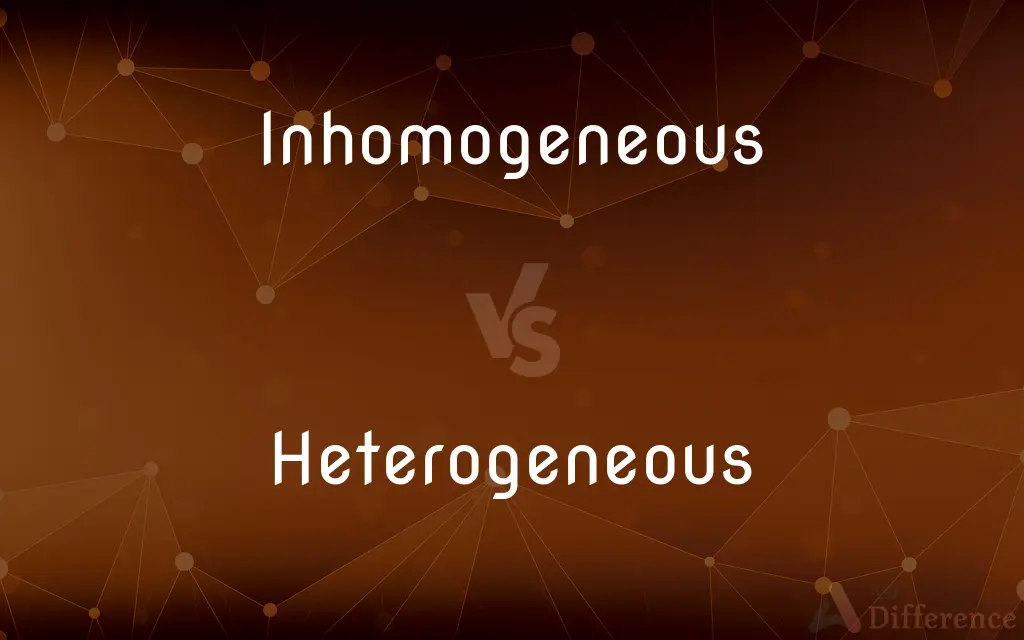Inhomogeneous vs. Heterogeneous — What's the Difference?
Edited by Tayyaba Rehman — By Urooj Arif — Updated on March 28, 2024
Inhomogeneous refers to a lack of uniformity within a structure, while heterogeneous implies a composition of dissimilar elements.

Difference Between Inhomogeneous and Heterogeneous
Table of Contents
ADVERTISEMENT
Key Differences
Inhomogeneous materials or structures lack uniformity in their composition or characteristics across their volume. This term is often used in physics and material science to describe properties that vary from one point to another. Whereas, heterogeneous materials are composed of different types of elements or compounds, clearly emphasizing the diversity within a system. While both terms suggest variation, inhomogeneous focuses more on the uneven distribution of properties, and heterogeneous on the presence of distinct, differing components.
In the context of materials science, an inhomogeneous material might have varying densities or compositions at different points, affecting its overall behavior and properties. On the other hand, a heterogeneous mixture, such as concrete, is made of cement, water, sand, and gravel, each maintaining its own identity within the mix. The emphasis is on the mixture’s composition from different substances rather than on the uniform distribution of its properties.
In medical imaging, an inhomogeneous tissue could imply areas within an organ that have differing densities or compositions, potentially indicating pathology. Heterogeneous, in a similar medical context, might describe a tumor composed of various cell types, highlighting the diversity within the pathological tissue. Inhomogeneous focuses on the non-uniform characteristics, while heterogeneous points to the composite nature of the structure.
In environmental science, an inhomogeneous atmosphere refers to variations in temperature, humidity, or pollutant concentration at different altitudes or locations. A heterogeneous ecosystem, by contrast, contains a diverse range of species, habitats, and ecological processes, underscoring the variety of life and environmental interactions. The former term describes spatial or qualitative variations, whereas the latter illustrates diversity in components or entities.
Despite their similarities, inhomogeneous and heterogeneous are used differently across disciplines. Inhomogeneous often describes a continuous medium with varying properties, whereas heterogeneous is used for mixtures or systems composed of distinct, identifiable parts or phases. This distinction helps in understanding material properties, system behaviors, and even in diagnosing medical conditions.
ADVERTISEMENT
Comparison Chart
Definition
Lacking uniformity in structure or composition.
Composed of dissimilar or diverse elements.
Context
Physics, material science.
Chemistry, biology, ecology.
Focus
Variability in properties.
Diversity of components.
Examples
Varying density in a metal alloy.
Mixture of oil and water.
Usage
Describes continuous mediums with uneven properties.
Used for mixtures with distinct, identifiable components.
Compare with Definitions
Inhomogeneous
Lacking uniformity across a structure.
The inhomogeneous soil made it difficult for farmers to predict irrigation needs.
Heterogeneous
Diverse in composition or character.
A heterogeneous workforce brings a wide range of skills and perspectives.
Inhomogeneous
Non-uniform distribution in a system.
The inhomogeneous distribution of pollutants complicates environmental cleanup efforts.
Heterogeneous
Made up of parts that remain separate.
Heterogeneous mixtures like salads are easy to identify individual ingredients in.
Inhomogeneous
Uneven in nature.
Inhomogeneous cooling led to the formation of cracks in the glass.
Heterogeneous
Contains elements not uniformly distributed.
Heterogeneous networks combine wired and wireless communication technologies.
Inhomogeneous
Varies in composition or property.
Inhomogeneous materials require careful analysis to understand their complex behaviors.
Heterogeneous
Composed of different kinds of elements.
Heterogeneous catalysts are used to speed up chemical reactions.
Inhomogeneous
Differing in characteristics at different points.
MRI scans revealed inhomogeneous tissue density in the liver.
Heterogeneous
Varied in nature or kind.
The heterogeneous landscape of the park offers various habitats for wildlife.
Inhomogeneous
Lack of homogeneity.
Heterogeneous
Diverse in character or content
A large and heterogeneous collection
Inhomogeneous
Something that is not homogeneous or uniform.
Heterogeneous
Also het·er·og·e·nous (hĕt′ə-rŏjə-nəs) Consisting of dissimilar elements or parts; not homogeneous.
Inhomogeneous
Not homogeneous
Heterogeneous
Xenogeneic.
Inhomogeneous
Not homogeneous
Heterogeneous
Diverse in kind or nature; composed of diverse parts.
Heterogeneous
(mathematics) Incommensurable because of different kinds.
Heterogeneous
Having more than one phase (solid, liquid, gas) present in a system or process.
Heterogeneous
(chemistry) Visibly consisting of different components.
Heterogeneous
(computing) Of a network comprising different types of computers, potentially with vastly differing memory sizes, processing power and even basic underlying architecture; alternatively, of a data resource with multiple types of formats.
Heterogeneous
Differing in kind; having unlike qualities; possessed of different characteristics; dissimilar; - opposed to homogeneous, and said of two or more connected objects, or of a conglomerate mass, considered in respect to the parts of which it is made up.
Heterogeneous
Consisting of elements that are not of the same kind or nature;
The population of the United States is vast and heterogeneous
Heterogeneous
Originating outside the body
Common Curiosities
What does inhomogeneous mean?
Inhomogeneous describes a lack of uniformity within a structure or material, where properties vary across its volume.
What challenges do inhomogeneous materials present?
Inhomogeneous materials pose challenges in predicting and controlling their behavior, affecting their application in engineering and technology.
How can inhomogeneity affect materials?
Inhomogeneity in materials can lead to variations in physical properties, affecting their strength, conductivity, or behavior under different conditions.
Why is it important to identify heterogeneous systems?
Identifying heterogeneous systems is crucial for understanding the composition and behavior of mixtures in chemistry, biology, and environmental science.
Can a system be both inhomogeneous and heterogeneous?
Yes, a system can be both inhomogeneous and heterogeneous if it has a non-uniform distribution of different types of components.
Why might a chemist be interested in heterogeneous mixtures?
Chemists study heterogeneous mixtures to understand how different substances interact, which is important for reactions, separations, and material synthesis.
What is a heterogeneous mixture?
A heterogeneous mixture is one that consists of visibly different components or phases, each retaining its own properties.
How is inhomogeneity detected?
Inhomogeneity is often detected through imaging, testing, or analysis techniques that reveal variations in material or biological properties.
How can one manage heterogeneous systems?
Managing heterogeneous systems involves understanding the composition and interactions of their components to optimize performance or outcomes.
How do inhomogeneous and heterogeneous relate to science?
Both terms are vital in science for describing variations and diversity in materials, systems, and environments, influencing research and application strategies.
What role does heterogeneity play in ecology?
Heterogeneity in ecology highlights the diversity of species, habitats, and ecological processes, essential for maintaining biodiversity and ecosystem health.
What implications does inhomogeneity have for medical imaging?
Inhomogeneity in medical imaging can indicate pathology, requiring careful interpretation to diagnose and treat conditions accurately.
Can inhomogeneous conditions lead to problems?
Inhomogeneous conditions can lead to issues in manufacturing, material performance, and even in diagnosing medical conditions due to uneven properties.
How does heterogeneity affect ecosystems?
Heterogeneity affects ecosystems by providing diverse niches, which support a wide range of species and complex ecological interactions.
How do inhomogeneous and heterogeneous concepts improve scientific understanding?
These concepts improve scientific understanding by providing frameworks to study and describe the complexity and diversity in natural and engineered systems.
Share Your Discovery

Previous Comparison
Usually vs. Always
Next Comparison
Masonry vs. BricklayingAuthor Spotlight
Written by
Urooj ArifUrooj is a skilled content writer at Ask Difference, known for her exceptional ability to simplify complex topics into engaging and informative content. With a passion for research and a flair for clear, concise writing, she consistently delivers articles that resonate with our diverse audience.
Edited by
Tayyaba RehmanTayyaba Rehman is a distinguished writer, currently serving as a primary contributor to askdifference.com. As a researcher in semantics and etymology, Tayyaba's passion for the complexity of languages and their distinctions has found a perfect home on the platform. Tayyaba delves into the intricacies of language, distinguishing between commonly confused words and phrases, thereby providing clarity for readers worldwide.













































